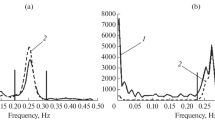Abstract
The authors evaluated the significance of individual properties (extroversion and individual anxiety) in the analysis of cardiorhythmograms. The subjects demonstrated significant correlations between the spectral characteristics of cardiac rhythm and extroversion and individual anxiety levels. The correlation between the spectral characteristics of the cardiac rhythm and extroversion significantly strengthened when the individual anxiety level was taken into account and vice versa. Cardiorhythmograms differed significantly in extroverts and introverts with increased and normal levels of individual anxiety.
Similar content being viewed by others
REFERENCES
Yavelov, I.S., Gratsianskii, N.A., and Zuikov, Yu.A., Variability of Cardiac Rhythm in Patients with Acute Coronary Syndromes: Their Significance for Evaluation and Prognosis of the Disease (Part 1), Kardiologiya, 1997, no. 2, p. 74.
Yavelov, I.S., Gratsianskii, N.A., and Zuikov, Yu.A., Variability of Cardiac Rhythm in Patients with Acute Coronary Syndromes: Their Significance for Evaluation and Prognosis of the Disease (Part 2), Kardiologiya, 1997, no. 3, p. 74.
Bigger, J.T., Fleiss, J.L., and Rolnitzky, L.M., Time Course of Recovery of Heart Period Variability after Myocardial Infarction, J. Am. Coll. Cardiol., 1991, vol. 18, p. 1643.
Heart Rate Variability: Standards of Measurement, Physiological Interpretation, and Clinical Use, in Task Force of European Society of Cardiology and the North American Society of Pacing and Electrophysiology: Membership of the Task Force Listed in the Appendix Eur. Heart J., 1996, vol. 17, p. 334.
Kuterman, E.M., Study and Development of the Methods of Analyzing CR by a System of Automated Evaluation of Postsurgical Patients' State, Abstract of Cand. Sci. (Med.) Dissertation, Moscow, 1977.
Shamliyan, T.A. and Arushanyan, E.B., Predictive Significance of Synchronous Shifts in Variant Pulsometry Indices during Drug Therapy in Patients with Ischemic Heart Disease, Kardiologiya, 1994, no. 4, p. 98.
Analiz serdechnogo ritma (Cardiac Rhythm Analysis), Žemaityte, D. and Telknis, L., Eds., Vilnius: Moklas, 1982.
Žemaityte, D.I., Correlation between the Reaction of the Cardiac Rhythm to Active Orthostatic Test and Characteristics of Central Hemodynamics, Fiziol. Chel., 1989, vol. 15, no. 2, p. 30.
Vegetativnye rasstroistva: klinika, diagnostika, lechenie (Autonomic Disorders: Clinical Picture, Diagnosis, and Treatment), Vein, A.M., Ed., Moscow: Mosk. Inform. Agentstvo, 1998.
Malik, M. and Camm, A.J., Heart Rate Variability, Clin. Cardiol., 1990, vol. 13, p. 570.
Akselrod, S., Gordon, D., and Ubel, F.A., Power Spectrum Analysis of Heart Rate Fluctuation: a Quantitative Probe of Beat-to-Beat Cardiovascular Control, Science, 1984, vol. 213, no. 10, p. 220.
Ori, Z., Monir, G., Weiss, J., et al., Heart Rate Variability Frequency Domain Analysis, Amb. Electrocard., 1992, vol. 10, no. 3, p. 499.
Baevskii, R.M., Cybernetic Analysis of Cardiac Rhythm Regulation, in Aktual'nye problemy fiziologii i patologii krovoobrashcheniya, (Topical Problems of Circulation Physiology and Pathology), Moscow: Meditsina, 1976, p. 161.
Visaladze, K.S. and Kavtaradze, G.V., Psychological Profile of Patients with Ischemic Heart Disease, Kardiologiya, 1984, vol. 24, no. 2, p. 73.
Kuterman, E.M. and Khaspekova, N.B., Typological Features of Tonic Components of the Cardiac Rhythm, Fiziol. Chel., 1995, vol. 21, no. 6, p. 146.
Clark, L.A., Watson, D., and Mineka, S., Temperament, Personality, and the Mood and Anxiety Disorders, J. Abnorm. Psychol., 1994, vol. 103, no. 7, p. 103.
Fried, R. and Fried, B., Cardiac Activity in a Simple Reaction Time Task: Predictive Value of Personality Measures, Pavlov J. Biol. Sci., 1981, vol. 16, no. 3, p. 151.
Imai, K. and Nakachi, K., Personality and Life Style, Nippon Koshu Eisei Zasshi, 1990, vol. 37, no. 8, p. 577.
Hinton, J.W. and Craske, B., Differential Effects of Test Stress on the Heart Rates of Extraverts and Introverts, Biol. Psychol., 1977, vol. 5, no. 1, p. 23.
Pearson, G.L. and Freeman, F.G., Effects of Extraversion and Mental Arithmetic on Heart Rate Reactivity, Percept. Mot. Skills, 1991, vol. 72, no. 3, pt. 2, p. 1239.
Rollin McCraty, M.S., Atkinson, M., Tiller, W.A., et al., The Effect of Emotions on Short-Term Power Spectrum Analysis of Heart Rate Variability, Am. J. Cardiol., 1995, vol. 76, no. 14, p. 1089.
Snidman, N., Kagan, J., Riordan, L., and Shannon, D.S., Cardiac Function and Behavioral Reactivity during Infancy, Psychophysiology, 1995, vol. 32, no. 3, p. 199.
Kupriyanova, O.O., Nidekker, I.G., and Brodetskaya, E.E., Wave Structure of Cardiac Rhythm in Healthy Chuldren, Fiziol. Chel., 1988, vol. 14, no. 2, p. 328.
Slobodskaya, E.R., Dynamics of Orthoclinostasis and Individual Features of Cardiac Rhythm in Infants, Fiziol. Chel., 1995, vol. 21, no. 2, p. 54.
Nidekker, I.G. and Fedorov, B.M., Problem of Mathematical Analysis of Cardiac Rhythm, Fiziol. Chel., 1993, vol. 19, no. 3, p. 80.
Ahmed, M.W., Kadish, A.H., and Parker, M.A., Effect of Pharmacologic Adrenergetic Stimulation on Heart Rate Variability, J. Am. Coll. Cardiol., 1994, vol. 24, p. 1082.
Davis, C., Reliability of Psychophysiological Assessment within Temperament Groups, Int. J. Psychol., 1988, vol. 6, no. 4, p. 299.
Petrova, E.V., Psikhologicheskie tipy Yunga. Metodicheskie materialy k treningu individual'nogo stilya s prilozheniem oprosnika Keirsi (Young's Psychological Types: Methodological Materials for Training an Individual Style with Keirsey's Questionnaire Attached), St. Petersburg: Mebius, 1997.
Bass, C., Type A Behavior in Patients with Chest Pain: Test–Retest Reliability and Psychometric Correlates of Bortner Scale, J. Psychosom. Res., 1984, vol. 28, no. 4, p. 289.
Baldzer, K. and Dykes, F.D., Heart Rate Variability Analysis in Full-Term Infants: Spectral Indices for Study of Neonatal Cardiorespiratory Control, Pediatr. Res., 1989, vol. 26, no. 3, p. 188.
Dartsmeliya, V.A. and Belkaniya, G.S., Typological Characteristic of Orthostatics Hemodynamic States in Healthy Subjects, Kosm. Biol., 1983, no. 2, p. 26.
Author information
Authors and Affiliations
Rights and permissions
About this article
Cite this article
Medvedev, M.A., Zagulova, D.V., Nesterenko, A.I. et al. Significance of Individual Features in Interpreting the Indices of Spectral Components of the Cardiac Rhythm. Human Physiology 28, 296–301 (2002). https://doi.org/10.1023/A:1015552601770
Issue Date:
DOI: https://doi.org/10.1023/A:1015552601770




